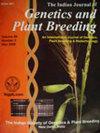Utilization of within location non-replicated multi-locational yield trials and GGE biplot methods for testing adaptability of tea [(Camellia sinensis (L.) O. Kuntze)] over diverse environments
IF 0.8
4区 生物学
Q3 PLANT SCIENCES
引用次数: 1
Abstract
Selection of tea [Camellia sinensis (L.) O. Kuntze] cultivars with wide adaptability over diverse environments is an important criteria to get prior information to recommend the cultivar for a particular region. A study was carried out to identify the most adaptable and stable tea genotypes for recommendation in the Up-country tea growing region in Sri Lanka by evaluating several potential tea genotypes for their wide adaptability and stability over diverse environments based on the analysis of GE interaction using within location non-replicated multi-environmental yield trials and GGE biplot methods. Six promising tea genotypes with desirable agronomic traits selected based on preliminary yield trials were evaluated along with a standard check in large scale within location non-replicated multi-locational yield trials at six locations (tea estates) in the Up-country tea growing region in Sri Lanka. The crop yields were recorded by harvesting green leaves in every seven days for three years covering six seasons (1st pruning cycle). Yield data were analyzed by within location non-replicated multi-locational yield trials and GGE biplot analysis. The genotype 272 was identified as the most adaptable and stable genotype followed by 582 and rest of the genotypes showed poor adaptability in the test region.利用定位内非重复多地点产量试验和GGE双标图法测定茶叶适应性[j]。O. Kuntze)]在不同的环境中
茶的选择[Camellia sinensis (L.)]对不同环境具有广泛适应性的品种是获得先验信息以推荐特定地区品种的重要标准。为了确定斯里兰卡内陆茶叶种植区最具适应性和稳定性的茶叶基因型,开展了一项研究,该研究基于转基因相互作用的分析,利用非重复的多环境产量试验和转基因双图方法,评估了几种潜在的茶叶基因型在不同环境中的广泛适应性和稳定性。根据初步产量试验选择了六种具有理想农艺性状的有希望的茶叶基因型,并在斯里兰卡内陆茶叶种植区的六个地点(茶园)进行了大规模的非重复多地点产量试验,对其进行了评估和标准检查。在连续3年6个季节(第1个修剪周期)中,每7天收获一次绿叶,记录作物产量。产量数据通过区域内非重复多区域产量试验和GGE双图分析进行分析。272基因型适应性最强,稳定性最好,582基因型次之,其余基因型在试验区适应性较差。
本文章由计算机程序翻译,如有差异,请以英文原文为准。
求助全文
约1分钟内获得全文
求助全文
来源期刊

Indian Journal of Genetics and Plant Breeding
PLANT SCIENCES-
CiteScore
1.80
自引率
10.00%
发文量
0
审稿时长
6-12 weeks
期刊介绍:
Advance the cause of genetics and plant breeding and to encourage and promote study and research in these disciplines in the service of agriculture; to disseminate the knowledge of genetics and plant breeding; provide facilities for association and conference among students of genetics and plant breeding and for encouragement of close relationship between them and those in the related sciences; advocate policies in the interest of the nation in the field of genetics and plant breeding, and facilitate international cooperation in the field of genetics and plant breeding.
 求助内容:
求助内容: 应助结果提醒方式:
应助结果提醒方式:


